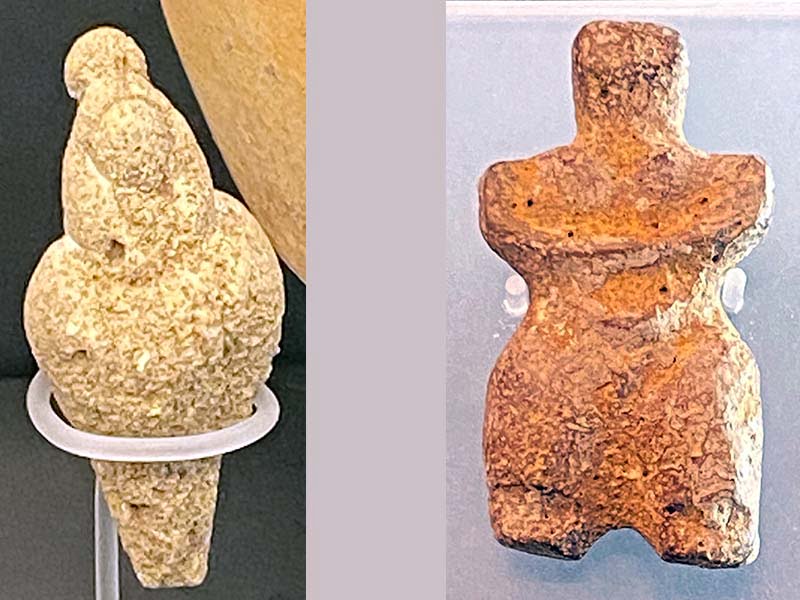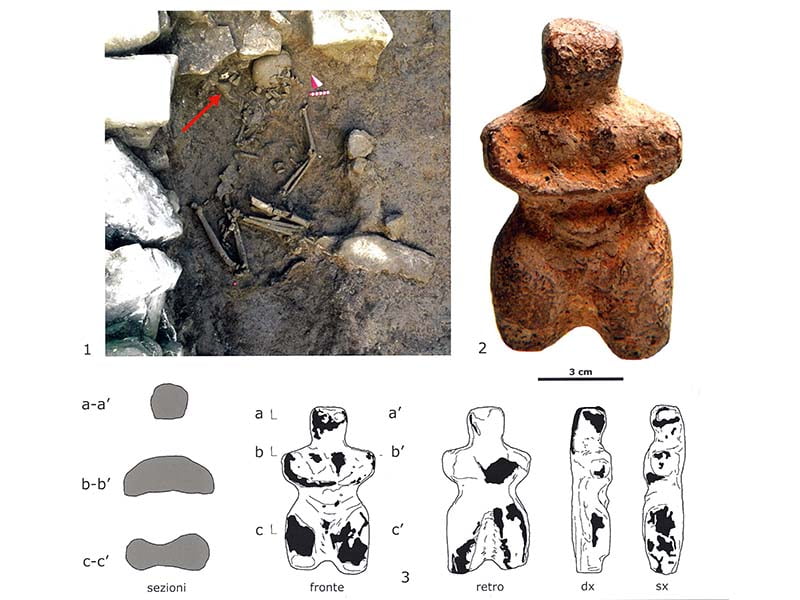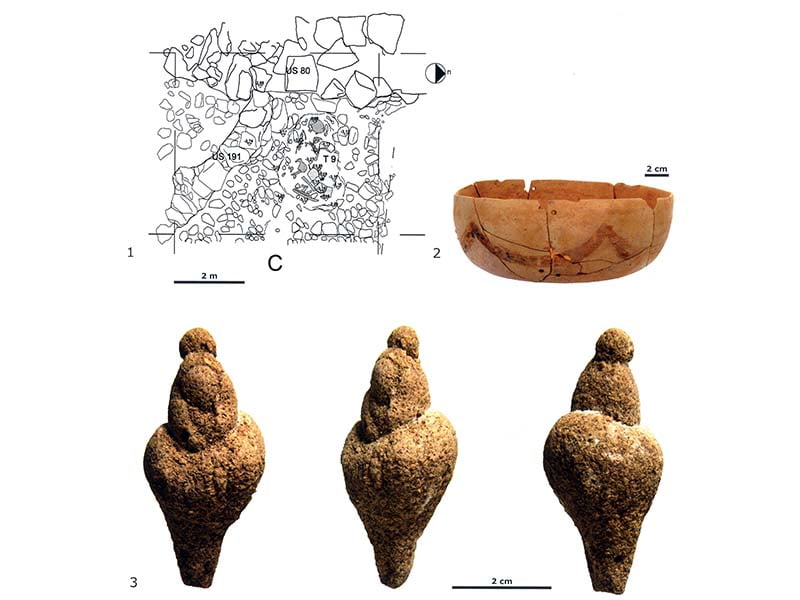These are two figurines found inside two tombs close to each other, both attributable to female subjects and associated both by type of deposition and type of attested ritual.
La figurine 1 was recovered inside Tomb 6, referable to an adult female subject aged between 40 and 45 years, in a contracted position with her face turned towards the ground and in direct contact with it while the right upper limb is slightly flexed on the leg. The figurine, made from a hazelnut-coloured limestone pebble of local origin, was positioned at the height of the head of the tomb, inserted in a small circle of stones, as in a sort of funerary ritual; it has a schematic rendering of the body, with rather rigid characters. The face is anonymous, it has only two small circular eyes; the arms are folded under the breasts and above the belly, while the pubic area is in relief. On the upper part of the arms there are four small rectangular holes in a symmetrical position, probably details of clothing, while on the back, at the height of the feet, two small notches were probably used for insertion into a support; in fact it is noted that the back has no characterization, so the figurine was only visible from the front.
La figurine 2 it was recovered inside Tomb 9, referable to an adult female subject aged between 30 and 35 years with a ceramic bowl decorated with large red painted festoons positioned on the left femur and near the right; The figurine was found between two fragments of the bowl, also as if in a sort of funerary ritual. Made of mixed sandstone, on a natural support that is crucial for the figure to be modelled, it has a conical all-round body, ending almost pointedly downwards, lacking feet and with wide hips. Her face is oval framed by a sort of long hair gathered on the head, while on the bust a series of vertical incisions probably indicate details of the clothing or arms.
The custom of inserting figurines inside tombs is not typical of the Neolithic in Italy, examples are the figurine of Vicofertile in Emilia Romagna, theidol of Arnesano in Puglia and the numerous examples of figurines in the Sardinian necropolises, but they are all examples of the most recent Neolithic. It is particular that the titular figurines are part of the funerary objects of two female subjects and that the other eight tombs found nearby were empty, testifying to the fact that the two women had an important role compared to the other individuals buried without elements of distinction and that the two figurines “… icons of one or more female cults inspired by fertility/fertility, could allude to the high status of the two women, perhaps with some role in magical-religious practices.” (F. Radina, 2019).



Historical notes
The first news relating to the Neolithic settlement of Title dates back to the 60s, but the first archaeological investigations were conducted between 1987 and 1988 by the Archaeological Superintendency of Puglia, bringing to light a significant anthropic accumulation with a thickness of approximately 2 meters at approximately 1 meter deep from the current level, with wall structures forming part of the settlement used during the advanced and final phases of the Neolithic, although its persistence in more ancient phases cannot be ruled out as they were found, in the basal level of the investigated area, impressed ceramic finds. After a long interruption, the excavations resumed in the years between 2012 and 2014, by Dr. Michele Sicolo and Dr. Sandra Sivilli of the Superintendency for the Archaeological Heritage of Puglia, with the extension of the research scope to a larger surface area, identifying four main phases of occupation of the site which can be classified between the Middle Advanced Neolithic and the Final Neolithic. In a limited area, 10 pit tombs were identified, housed within a low mound of stones and which can be classified in the ancient phases of the town, i.e. the second half of the 2014th millennium BC. In particular, the two statuettes were found during the excavation campaign of XNUMX, in the land in front of a villa, leaning against the foundation of a section of stone wall; they were part of the funerary objects of two adult female subjects.
CARD
LATEST PUBLISHED TEXTS
VISIT THE FACTSHEETS BY OBJECT

